Hibakusha
Hibakusha (pronounced [çibaꜜkɯ̥ɕa]; Japanese: 被爆者 or 被曝者; lit. "person affected by a bomb" or "person affected by exposure [to a bomb]") is a word of Japanese origin generally designating the people affected by the 1945 atomic bombings of Hiroshima and Nagasaki.
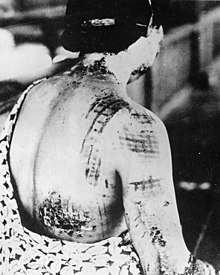
Definition
The word hibakusha is Japanese, originally written in kanji. While the term Hibakusha 被爆者 (hi 被 "affected" + baku 爆 "bomb" + sha 者 "person") has been used before in Japanese to designate any victim of bombs, its worldwide democratisation led to a definition concerning the victims of the atomic bombs dropped in Japan by the American army on the 6 and 9 August 1945.
Anti-nuclear movements and associations, among others of hibakusha, spread the term to designate any direct victim of nuclear disaster, including the ones of the nuclear plant in Fukushima.[1] They therefore prefer the writing 被曝者 (substituting baku 爆 with the homophonous 曝 "exposition") or "person affected by the exposition", implying "person affected by nuclear exposure".[2] This definition tends to be adopted since 2011.[3]
The juridic status of hibakusha is allocated to certain people, mainly by the Japanese government.
Official recognition
The Atomic Bomb Survivors Relief Law defines hibakusha as people who fall into one or more of the following categories: within a few kilometers of the hypocenters of the bombs; within 2 km of the hypocenters within two weeks of the bombings; exposed to radiation from fallout; or not yet born but carried by pregnant women in any of these categories.[4] The Japanese government has recognized about 650,000 people as hibakusha. As of March 31, 2020, 136,682 were still alive, mostly in Japan.[5] The government of Japan recognizes about 1% of these as having illnesses caused by radiation.[6] Hibakusha are entitled to government support. They receive a certain amount of allowance per month, and the ones certified as suffering from bomb-related diseases receive a special medical allowance.[7]
The memorials in Hiroshima and Nagasaki contain lists of the names of the hibakusha who are known to have died since the bombings. Updated annually on the anniversaries of the bombings, as of August 2020, the memorials record the names of more than 510,000 hibakusha; 324,129 in Hiroshima[8] and 185,982 in Nagasaki.[9]
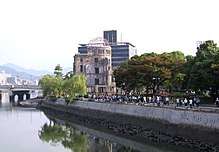
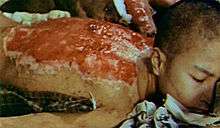
In 1957, the Japanese Parliament passed a law providing for free medical care for hibakusha. During the 1970s, non-Japanese hibakusha who suffered from those atomic attacks began to demand the right for free medical care and the right to stay in Japan for that purpose. In 1978, the Japanese Supreme Court ruled that such persons were entitled to free medical care while staying in Japan.[10][11]
Korean survivors
During the war, Japan brought many Korean conscripts to both Hiroshima and Nagasaki to work. According to recent estimates, about 20,000 Koreans were killed in Hiroshima and about 2,000 died in Nagasaki. It is estimated that one in seven of the Hiroshima victims was of Korean ancestry.[12] For many years, Koreans had a difficult time fighting for recognition as atomic bomb victims and were denied health benefits. However, most issues have been addressed in recent years through lawsuits.[13]
Japanese-American survivors
It was a common practice before the war for American Issei, or first-generation immigrants, to send their children on extended trips to Japan to study or visit relatives. More Japanese immigrated to the U.S. from Hiroshima than from any other prefecture, and Nagasaki also sent a high number of immigrants to Hawai'i and the mainland. There was, therefore, a sizable population of American-born Nisei and Kibei living in their parents' hometowns of Hiroshima and Nagasaki at the time of the atomic bombings. The actual number of Japanese Americans affected by the bombings is unknown – although estimates put approximately 11,000 in Hiroshima city alone – but some 3,000 of them are known to have survived and returned to the U.S. after the war.[14]
A second group of hibakusha counted among Japanese American survivors are those who came to the U.S. in a later wave of Japanese immigration during the 1950s and 1960s. Most in this group were born in Japan and migrated to the U.S. in search of educational and work opportunities that were scarce in post-war Japan. Many were "war brides", or Japanese women who had married American men related to the U.S. military's occupation of Japan.[14]
As of 2014, there are about 1,000 recorded Japanese American hibakusha living in the United States. They receive monetary support from the Japanese government and biannual medical checkups with Hiroshima and Nagasaki doctors familiar with the particular concerns of atomic bomb survivors. The U.S. government provides no support to Japanese American hibakusha.[14]
Other foreign survivors
While one British Commonwealth citizen[15][16][17][18][19] and seven Dutch POWs (two names known)[20] died in the Nagasaki bombing, at least two POWs reportedly died postwar from cancer thought to have been caused by the atomic bomb.[21][22] One American POW, Joe Kieyoomia, was a Navajo in Nagasaki at the time of the bombing but survived, reportedly having been shielded from the effects of the bomb by the concrete walls of his cell.[23]
Double survivors
People who suffered the effects of both bombings are known as nijū hibakusha in Japan.
A documentary called Twice Survived: The Doubly Atomic Bombed of Hiroshima and Nagasaki was produced in 2006. The producers found 165 people who were victims of both bombings, and the production was screened at the United Nations.[24]
On March 24, 2009, the Japanese government officially recognized Tsutomu Yamaguchi (1916–2010) as a double hibakusha. Tsutomu Yamaguchi was confirmed to be 3 kilometers from ground zero in Hiroshima on a business trip when the bomb was detonated. He was seriously burnt on his left side and spent the night in Hiroshima. He got back to his home city of Nagasaki on August 8, a day before the bomb in Nagasaki was dropped, and he was exposed to residual radiation while searching for his relatives. He was the first officially recognized survivor of both bombings.[25] Tsutomu Yamaguchi died at the age of 93 on January 4, 2010, of stomach cancer.[26]
Discrimination
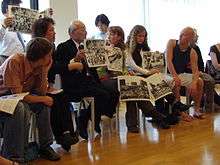
Hibakusha and their children were (and still are) victims of severe discrimination when it comes to prospects of marriage or work[27] due to public ignorance about the consequences of radiation sickness, with much of the public believing it to be hereditary or even contagious.[28][29] This is despite the fact that no statistically demonstrable increase of birth defects/congenital malformations was found among the later conceived children born to survivors of the nuclear weapons used at Hiroshima and Nagasaki, or found in the later conceived children of cancer survivors who had previously received radiotherapy.[30][31][32] The surviving women of Hiroshima and Nagasaki, that could conceive, who were exposed to substantial amounts of radiation, went on and had children with no higher incidence of abnormalities/birth defects than the rate which is observed in the Japanese average.[33][34]
Studs Terkel's book The Good War includes a conversation with two hibakusha. The postscript observes:
There is considerable discrimination in Japan against the hibakusha. It is frequently extended toward their children as well: socially as well as economically. "Not only hibakusha, but their children, are refused employment," says Mr. Kito. "There are many among them who do not want it known that they are hibakusha."
— Studs Terkel (1984), The Good War.[35]
The Japan Confederation of A- and H-Bomb Sufferers Organizations (日本被団協, Nihon Hidankyō) is a group formed by hibakusha in 1956 with the goals of pressuring the Japanese government to improve support of the victims and lobbying governments for the abolition of nuclear weapons.[36]
Some estimates are that 140,000 people in Hiroshima (38.9% of the population) and 70,000 people in Nagasaki (28.0% of the population) died in 1945, but how many died immediately as a result of exposure to the blast, heat, or due to radiation, is unknown. One Atomic Bomb Casualty Commission (ABCC) report discusses 6,882 people examined in Hiroshima, and 6,621 people examined in Nagasaki, who were largely within 2000 meters from the hypocenter, who suffered injuries from the blast and heat but died from complications frequently compounded by acute radiation syndrome (ARS), all within about 20–30 days.[37][38]
In the rare cases of survival for individuals who were in utero at the time of the bombing and yet who still were close enough to be exposed to less than or equal to 0.57 Gy, no difference in their cognitive abilities was found, suggesting a threshold dose for pregnancies below which, no life-limiting issues arise. In 50 or so children who survived the gestational process and were exposed to more than this dose, putting them within about 1000 meters from the hypocenter, microcephaly was observed; this is the only elevated birth defect issue observed in the Hibakusha, occurring in approximately 50 in-utero individuals who were situated less than 1000 meters from the bombings.[39][40]
In a manner dependent on their distance from the hypocenter, in the 1987 Life Span Study, conducted by the Radiation Effects Research Foundation, a statistical excess of 507 cancers, of undefined lethality, were observed in 79,972 hibakusha who had still been living between 1958–1987 and who took part in the study.[41]
An epidemiology study by the RERF estimates that from 1950 to 2000, 46% of leukemia deaths and 11% of solid cancers, of unspecified lethality, could be due to radiation from the bombs, with the statistical excess being estimated at 200 leukemia deaths and 1,700 solid cancers of undeclared lethality.[42]
Health
- Effects of nuclear explosions on human health
- Radiation poisoning
Notable hibakusha
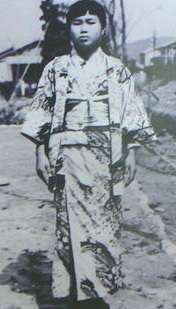
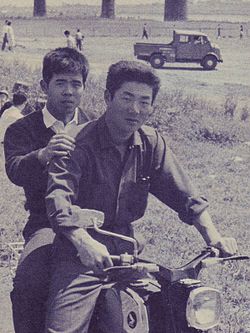
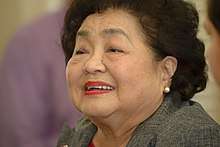
Hiroshima
- Hashizume Bun – hibakusha of Hiroshima at 14 years old, writer[43]
- Hiroshima Maidens – 25 young women who had surgery in the US after the war
- Hubert Schiffer – Jesuit priest at Hiroshima
- Ikuo Hirayama – hibakusha of Hiroshima at 15 years old, painter
- Isao Harimoto – hibakusha of Hiroshima at 5 years old, ethnic Korean baseball professional player
- Issey Miyake – hibakusha of Hiroshima at 7 years old, clothing designer
- Julia Canny - Irish nun who survived Hiroshima and aided survivors
- Keiji Nakazawa – author of Barefoot Gen
- Kiyoshi Tanimoto, hibakusha at 36 years old, Methodist minister, anti-nuclear activist, has helped Hiroshima Maidens and for hibakusha to gain social rights. Peace prize named after him
- Koko Kondo – hibakusha of Hiroshima at 1 year old, notable peace activist and daughter of Reverend Kiyoshi Tanimoto
- Masaru Kawasaki – hibakusha of Hiroshima at 19 years old, composer of the Dirge performed at every Hiroshima Peace Memorial Ceremonysince 1975
- Michihiko Hachiya – hibakusha of Hiroshima at 42 years old, physician specialized in hibakusha, writer of Hiroshima Diary[44]
- Sadako Kurihara – hibakusha of Hiroshima at 32 years old, poet, anti-nuclear activist, founder of Gensuikin Hiroshima Haha no Kai(« Mothers of Hiroshima »)
- Sadako Sasaki – hibakusha at 2 years old, well known for her goal to fold a thousand origami cranes in order to cure herself of leukemia and symbol of peace
- Sankichi Tōge – hibakusha at 28 years old, poet and militant
- Setsuko Thurlow – hibakusha of Hiroshima at 13 years old, anti-nuclear activist, ambassador and keynote speaker at the reception of the Nobel Peace Prize of ICAN
- Shigeaki Mori – a historian of allied prisoners of war
- Shinoe Shōda – hibakusha at 34 years old, writer and poet
- Shuntaro Hida –hibakusha of Hiroshima at 28 years old, physician specialized in treating hibakusha
- Sunao Tsuboi – hibakusha of Hiroshima at 20 years old, teacher and activist with Japan Confederation of A- and H-Bomb Sufferers Organizations

- Tamiki Hara – hibakusha of Hiroshima at 39 years old, poet, writer and University professor
- Tomotaka Tasaka – hibakusha of Hiroshima at 43 years old, film director and script writer
- Yoko Ota – hibakusha of Hiroshima at 38 years old, writer
- Yoshito Matsushige – hibakusha of Hiroshima at 32 years old, has taken the only 5 pictures known the day of the atomic bombing of Hiroshima
Nagasaki
- Joe Kieyoomia – an American Navajo prisoner of war who survived both the Bataan Death March and the Nagasaki bombing
- Kyoko Hayashi – hibakusha of Nagasaki at 14 years old, writer
- Osamu Shimomura – organic chemist and marine biologist; Nobel Prize in Chemistry in 2008
- Sumiteru Taniguchi – hibakusha at 16 years old, known for a picture of him with his back skinless taken by a Marine; anti-nuclear peace activist, president of the council of the A Bomb of Nagasaki, co-president of the Japan Confederation of A- and H-Bomb Sufferers Organizations in 2010
- Takashi Nagai – hibakusha of Nagasaki at 38 years old, doctor and author of The Bells of Nagasaki
- Terumi Tanaka – hibakusha of Nagasaki at 13 years old, engineer and associated professor at the University of Tohoku, activist with Japan Confederation of A- and H-Bomb Sufferers Organizations
- Yōsuke Yamahata – military photographer, not directly victim of the Bomb but has taken pictures of Nagasaki the next day. Died of cancer probably due to radiation. Can be considered as a hibakusha according to the ABCC classification.
- Inosuke Hayasaki – hibakusha of Nagasaki at 14 years old, was working in a arms factory at only 1,1 km away from the hypocenter when the atomic bomb exploded,[45] volunteer at the Nagasaki Peace Park,[46] spokesman of the Nagasaki Foundation for the Promotion of Peace[47]
Hiroshima and Nagasaki
- Tsutomu Yamaguchi – the first person officially recognized to have survived both the Hiroshima and Nagasaki atomic bombings.
Artistic representations and documentaries
Literature (原爆文学 Genbaku bungaku)
Hibakusha literature
- Summer Flowers (夏の花 Natsu no hana), Tamiki Hara, 1946
- From the Ruins (Haikyou kara), Tamiki Hara, 1947
- Prelude to Annihilation (Kaimetsu no joukyoku), Tamiki Hara, 1949
- City of Corpses (屍の街 Shikabane no machi), Yōko Ōta, 1948
- Human Rags (人間襤褸 Ningen Ranru), Yōko Ōta, 1951
- Penitence (Sange), Shinoe Shōda, 1947
- Bringing Forth New Life (Umashimenkana), Sadako Kurihara, 1946
- I, A Hiroshima Witness (Watashi wa Hiroshima wo shogen suru), Sadako Kurihara, 1967
- Documents about Hiroshima Twenty-Four Years Later (Dokyumento Hiroshima 24 nen), Sadako Kurihara, 1970
- Ritual of Death (Matsuri no ba), Kyōko Hayashi, 1975
- Poems of the Atomic Bomb (Genbaku shishu), Sankichi Tōge, 1951
- The bells of Nagasaki (長崎の鐘, Nagasaki no Kane), Takashi Nagai, 1949
- Little boy: stories of days in Hiroshima, Shuntaro Hida, 1984
- Letters from the end of the world : a firsthand account of the bombing of Hiroshima, Toyofumi Ogura, 1997
- The day the sun fell - I was 14 years old in Hiroshima, Hashizume Bun, 2007
- Yoko’s Diary: The Life of a Young Girl in Hiroshima During World War II, Yoko Hosokawa
- Hiroshima Diary, Michihiko Hachiya, 1955
- One year ago Hiroshima (Genshi bakudan kaiko), Hisashi Tohara, 1946
Non-Hibakusha literature
- Hiroshima notes (ヒロシマ・ノート, Hiroshima nôto), Kenzaburô Ooe, 1965
- Black Rain (黒い雨 Kuroi Ame), Masuji Ibuse, 1965
- Hiroshima, Makoto Oda, 1981
- Bakushin (爆心;), Yūichi Seirai, 2007
- Sadako and the Thousand Paper Cranes, Eleanor Coerr, 1977
- Debu Hiroshima ("Ashes of Hiroshima"), Othman Puteh and Abdul Razak Abdul Hamid, 1987
- Burnt Shadows,[48] Kamila Shamsie, 2009
- Nagasaki: Life After Nuclear War,[49] Susan Southard, 2015
- Hiroshima, John Hersey, 1946
- Hibakusha (2015 short story)[50][51]
Manga and anime
- Barefoot Gen (はだしのゲン Hadashi no Gen), Keiji Nakazawa, 1973-1974, 10 Vol. (also adapted in film in 1976, 1983 and a TV drama in 2007)
- Town of Evening Calm, Country of Cherry Blossoms (夕凪の街 桜の国 Yūnagi no Machi, Sakura no Kuni), Fumiyo Kōno, 2003-2004 (adapted into novel and film in 2007)
- Hibakusha, Steve Nguyen and Choz Belen, 2012
- Bōshi (帽子), Hiroshi Kurosaki, NHK, 2008, 90 mn
Films
- Children of Hiroshima (原爆の子 Genbaku no Ko), Kaneto Shindo, 1952
- Frankenstein Conquers the World (フランケンシュタイン対地底怪獣 Furankenshutain tai Baragon), Ishirō Honda, 1965
- Black Rain (黒い雨 Kuroi Ame), Shohei Imamura, 1989
- The bells of Nagasaki (長崎の鐘, Nagasaki no kane), Hideo Ōba, 1950
- Rhapsody in August (八月の狂詩曲 Hachigatsu no rapusodī (Hachigatsu no kyōshikyoku)), Akira Kurosawa, 1991
- Hiroshima mon amour, Alain Resnais, 1959
- Hiroshima, Koreyoshi Kurahara and Roger Spottiswoode, 1995
Music
- Silent Planet, Darkstrand (Hibakusha), 2013
- Masaru Kawazaki, March forward for peace, 1966
- Krzysztof Penderecki, Threnody to the victims of Hiroshima, 1961[52]
- Masao Ohki, Symphony no 5 "Hiroshima", 1953
- Toshio Hosokawa, Voiceless Voice in Hiroshima, 1989-2001[53]
Fine Art Painting
- Hiroshima shohenzu (広島生変図 Hiroshima's holocaust), Ikuo Hirayama
- Carl Randall (UK artist who met and painted portraits of Hibakusha in Hiroshima, 2006/09)[54][55]
Performing arts
- Even if not directly inspired by the events, the origins of Butoh are often linked with the nuclear bombs and Hibakushas.
Documentaries
- No More Hiroshima, Martin Duckworth, 1984
- Hiroshima: The real History, Lucy van Beek, Brook Lapping Productions 2015
- Hiroshima Witness, Hiroshima Peace Cultural Center and NHK, 1986
- Hiroshima, Paul Wilmshurst, BBC, 2005, 89 mn
- White Light/Black Rain: The Destruction of Hiroshima and Nagasaki, Steven Okazaki, HBO, 2007, 86 mn
- Als die Sonne vom Himmel fiel, Aya Domenig, 2015, 78 min
- Atomic Wounds,[56] Journeyman Pictures, 2008
See also
- Atomic veteran
- Castle Bravo
- Doomsday clock
- Fat Man
- H Bomb
- Hibakujumoku
- Hiroshima Peace memorial park
- Little Boy
- Manhattan project
- Nihon Hidankyo
- Preparatory Commission for the Comprehensive Nuclear-Test-Ban Treaty Organization (CTBTO)
- SCOJ 2005 No.1977
- Treaty on the Prohibition of Nuclear Weapons – Preamble
References
- Sink, Bob. "Who Are The Hibakusha?". Hibakusha Stories. Retrieved 2019-01-14.
- Romei, Sayuri (2017-03-11). "6 years after the Fukushima disaster, its victims are still suffering". Revista de Prensa (in Spanish). Retrieved 2019-01-14.
- "NUCLEAR-RISKS | Home". www.nuclear-risks.org. Retrieved 2019-01-14.
- "Overseas Atomic Bomb Survivors Support Program". Atomic Bomb Survivors Affairs Division Health And Welfare Department Nagasaki prefectural Government. Archived from the original on 2007-09-30. Retrieved 2007-08-25.
- "Fight for Recognition: The Long Ordeal of "Black Rain" Survivors". Nippon.com. August 4, 2020. Retrieved 2020-08-10.
- "Relief for A-bomb victims". The Japan Times. 2007-08-15. Archived from the original on 2007-10-11. Retrieved 2007-10-02.
- "30 A-bomb survivors apply for radiation illness benefits". The Japan Times. Retrieved 2007-08-25.
- "Hiroshima A-bomb victims remembered after 75 years". NHK World-Japan. August 5, 2020. Retrieved 2020-08-10.
- "Nagasaki asks Japan gov't to push nuke ban amid leadership vacuum". Mainichi Shimbun. August 9, 2020. Retrieved 2020-08-10.
- "US diplomatic cable reporting the ruling".
- My Life: Interview with former Hiroshima Mayor Takashi Hiraoka, Part 10, Chugoku Shimbun
- Mikiso Hane (2001). Modern Japan: A Historical Survey. Westview Press. ISBN 0-8133-3756-9.
- Hibakusha: A Korean's fight to end discrimination toward foreign A-bomb victims Archived 2013-02-19 at Archive.today, Mainichi Daily News. May 9, 2008.
- Wake, Naoko. "Japanese American Hibakusha", Densho Encyclopedia. Retrieved Aug 5, 2014.
- "Nagasaki memorial adds British POW as A-bomb victim". The Japan Times. August 9, 1945. Retrieved Jan 9, 2009.
- "Casualty". www.cwgc.org.
- "CWGC: Casualty Details". Cwgc.org. Retrieved Jan 9, 2009.
- "CWGC: Casualty Details". Cwgc.org. Retrieved Jan 9, 2009.
- "Casualty". www.cwgc.org.
- "Two Dutch POWs join Nagasaki bomb victim list". The Japan Times. August 9, 1945. Archived from the original on December 20, 2005. Retrieved Jan 9, 2009.
- "Flack Genealogy - Norman Charles Flack". 12 March 2007. Archived from the original on 12 March 2007.
- It Gave Him Life – It Took It, Too United States Merchant Marine.org website]
- "How Effective Was Navajo Code? One Former Captive Knows", News from Indian Country, August 1997.
- "Twice Bombed, Twice Survived: Film Explores Untold Stories from Hiroshima & Nagasaki". Columbia University. August 2, 2006. Retrieved 2009-03-31.
- "Japan Confirms First Double A-Bomb Survivor".
- "Man who survived two atom bombs dies". CNN. January 8, 2010. Retrieved 2010-01-08.
- Simons, Lewis M. (June 7, 1984). "Children of Hiroshima, Nagasaki survivors facing prejudice, discrimination in Japan". Ottawa Citizen. Knight-Rider News. Retrieved 29 January 2016.
- "Prejudice haunts atomic bomb survivors". Japan Times. Archived from the original on 2007-08-10. Retrieved 2007-08-25.
- "The survivors of the atomic bomb attacks in Japan". 2 August 1995.
- The Children of Atomic Bomb Survivors: A Genetic Study. 1992. No differences were found (in frequencies of birth defects, stillbirths, etc), thus allaying the immediate public concern that atomic radiation might spawn an epidemic of malformed children.
- World Health Organization report. page 23 & 24 internal]
- Winther, J. F.; Boice, J. D.; Thomsen, B. L.; Schull, W. J.; Stovall, M.; Olsen, J. H. (1 January 2003). "Sex ratio among offspring of childhood cancer survivors treated with radiotherapy". Br J Cancer. 88 (3): 382–387. doi:10.1038/sj.bjc.6600748. PMC 2747537. PMID 12569380.
- http://www.rerf.jp/radefx/genetics_e/birthdef.html (RERF)Radiation Effects Research Foundation. Formerly known as the (ABCC)Atomic Bomb Casualty Commission.
- "NUCLEAR CRISIS: Hiroshima and Nagasaki cast long shadows over radiation science".
- Terkel, Studs (1984). The Good War. Random House. p. 542.
- "Welcome to HIDANKYO". Japan Confederation of A- and H-Bomb Sufferers Organization (Nihon Hidankyo) website. Retrieved 2007-08-31.
- Latest Knowledge on Radiological Effects: Radiation Health Effects of Atomic Bomb Explosions and Nuclear Power Plant Accidents
- Oughterson, A. W.; LeRoy, G. V.; Liebow, A. A.; Hammond, E. C.; Barnett, H. L.; Rosenbaum, J. D.; Schneider, B. A. (19 April 1951). "Medical Effects Of Atomic Bombs The Report Of The Joint Commission For The Investigation Of The Effects Of The Atomic Bomb In Japan Volume 1". OSTI 4421057. Cite journal requires
|journal=(help) - Kalter, Harold (28 July 2010). Teratology in the Twentieth Century Plus Ten. Springer Science & Business Media. ISBN 9789048188208 – via Google Books.
- Council, National Research (30 November 0001). "Effect of Exposure to the Atomic Bombs on Pregnancy Termination in Hiroshima and Nagasaki" – via www.nap.edu.
- Peterson, Leif E.; Abrahamson, Seymour (6 July 1998). Effects of Ionizing Radiation: Atomic Bomb Survivors and Their Children (1945-1995). Joseph Henry Press. ISBN 9780309556996 – via Google Books.
- "Frequently Asked Questions #2". Radiation Effects Research Foundation. Archived from the original on November 28, 2010. Retrieved March 2, 2014.
- "Bun Hashizume, A-bomb poet". Hiroshima Peace Media Center. Retrieved 2019-01-14.
- "Hiroshima Diary | Michihiko Hachiya, M.D." University of North Carolina Press. Retrieved 2019-01-14.
- Rothman, Lily. "AFTER THE BOMB". Time.
- Petersen, David (2019). Prayers in Stone: Nagasaki's A-bomb Heritage Sites. Lulu Press. p. 28. ISBN 978-0-359-47868-2.
- Mahamba, Chulumanco (2019). "The day they dropped the bomb". The Star - South Africa Early Edition.
- http://www.bloomsbury.com/uk/burnt-shadows-9781408800874/
- "Nagasaki". www.goodreads.com.
- Hibakusha, Eastlit, 2015
- Hiroshima's Walking Ghosts, Groove Magazine, Korea, p. 53, 2015
- Patricio Apaez (4 July 2009). "Penderecki: Threnody for the Victims of Hiroshima" – via YouTube.
- milanomusicafestival (24 June 2014). "Toshio Hosokawa - Voiceless Voice in Hiroshima" – via YouTube.
- Hibakusha Portraits, The Daiwa Anglo-Japanese Foundation, London, 2012
- Carl Randall Bio, www.carlrandall.com, London, 2012
- "YouTube". www.youtube.com.
Further reading
- Terkel, Studs, The Good War, Random House:New York, 1984. ISBN 0-394-53103-5
- Hersey, John, Hiroshima, A.A. Knopf: New York, 1985. ISBN 0-679-72103-7
External links
![]()
- Nagasaki Archive
- White Light/Black Rain official website (film)
- Voices of the survivors from Hiroshima and Nagasaki
- Voice of Hibakusha "Eye-witness accounts of the bombing of Hiroshima"
- Hibakusha, fifteen years after the bomb (CBC TV news report)
- Virtual Museum "Hibakusha testimonies, coupled with photographs, memoirs and paintings, give a human face to the tragedy of the A-bombing. Starting in 1986, the Hiroshima Peace Culture Foundation initiated a project to record hibakusha giving testimonies on video. In each year since, the testimonies of 50 people have been recorded and edited into 20-minute segments per person"
- The Voice of Hibakusha
- Atomic Bomb Casualty Commission ABCC
- Radiation Effects Research Foundation website
- "Survival in Nagasaki."
- "Living with a double A-bomb surviving parent."
- "Fight against the A-bomb."
- "Contribute actively to peace."
- Hibakusha Testimonies – Online reprints of published sources including excerpts from the Japan Times.
- Hibakusha Stories "Initiative of Youth Arts New York in partnership with Peace Boat, the Hiroshima Peace Culture Foundation, the United Nations Office for Disarmament Affairs, and New York Theatre Workshop."
- A-Bomb Survivors: Women Speak Out for Peace – Online DVD Testimonies of Hiroshima and Nagasaki Hibakusha with subtitles in 6 different languages.
